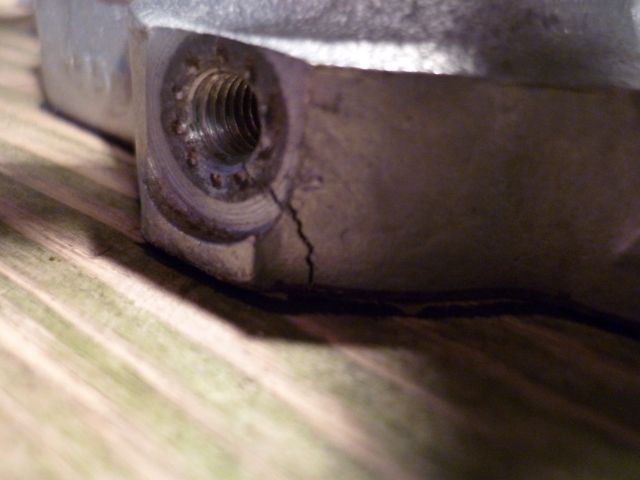It's all in the preparation right? Well, not exactly. All the preparation in the world won't save you from impatience and a lack of common sense.
Tappet blocks. I read up a lot on fitting Triumph tappet blocks, the more I researched the more worried I got. Not as easy as whacking them out and whacking them back in. You have to get them aligned - exactly. Not just so the nub on the end of the retaining bolt enters the hole in the block, it's slightly smaller than the locating hole. Enough for the block to twist substantially and skew the followers out of square to the camshaft lobes. So some precision is necessary. At the very least, you must have the correct tool - a two-pronged drift that fits in the follower tunnels in the block - to avoid damage and to be able, with the help of a wrench, to 'twist' the block as you drift it in to correct any misalignment.
The 'proper' tool is not particularly expensive, but expensive enough for me to decide to make my own rather than invest in a tool I'm only likely to use once....
I found that an old Norton conrod bolt was a snug fit in the follower tunnels in the block. I removed the threaded portions and cut a piece of 10mm plate to attach them to...

Half a CB750 rear wheel spindle later and a trip to the father-in-law for a bit of welding, and I had my own 'proper' tappet block insertion tool...

Next I had to figure out how to hold the cylinder block secure while I drifted the block in. I had read a tip on one of the Triumph forums about using a piece of 7x2 timber with holes cut to accept the cylinder sleeves and 'ears' of the blocks, thereby keeping the base fully supported...

I had also been warned about the possibility of the sleeves moving once the cylinders were heated up, so I made sure they would be held in place securely...

The new block for the exhaust side and correct locating bolts. I would be re-using the original (inlet side) block...

Both blocks and their corresponding homes in the cylinder base got a dressing with 1000 wet and dry, to remove any ridges and nubs that might pick up as they were driven home. Then the cylinder block went into the oven for twenty minutes at 200* C. She was not happy. I forgot I had given the sleeves a copious coating of WD40 after honing them, and as it evaporated it stunk the kitchen out. I actually quite liked it

...

I don't have a picture of the blocks being drifted in - it was a two handed job. I did it on concrete rather than the bench, to prevent any 'bounce' that may cause damage. I started with the new block, a few light taps with the club hammer, really using only the weight of it, saw it go in to within an eighth of it's seat. I stopped after every couple of taps, checking alignment as I went. At an eighth out though, it tightened up, which is where I should have stopped, knocked it out again, and investigated. But not me, oh no, I was
close, a couple more, significantly heavier 'taps' with the hammer saw it seated home. I lifted it up to inspect my precision work, and my heart sunk. Fck!...

Impatient, stupid. I couldn't bring myself to look at it for the rest of the day, and went into a sulk that would put a little girl to shame. Well, important things matter right?
Anyway, now I've had time to reflect upon my back-street balls-up, and sought a bit of advice, I don't think it's quite the end of the world. The cylinder base distorted slightly and I have managed to dress it flat again....

But oh sh1t that crack

So I need some ideas fellas. The tappet block is not going anywhere (incidentally, the inlet side 'fell' in and nipped up tightly as the cylinder cooled down). A welded repair would be the ultimate fix, but just not financially viable. It may also warp the base of the block and turn it into scrap. I can fit the cylinder block as it is but I am concerned that once things get hot I may see an oil leak there (not that I predict no oil leaks - it is a Triumph after all). The pictures might make it look worse than it is, the crack can best be described as 'hairline', but I would be happier if I could seal it up. Does anyone know of a 'liquid metal' type product with the right viscosity to leach in there? I thought about 'V-eeing' it slightly and using some JB Weld (still might) but as always would welcome your comments. Just please don't tell me what a prat I've been - already know that!
